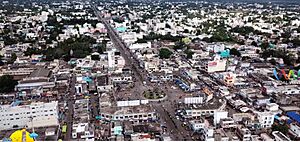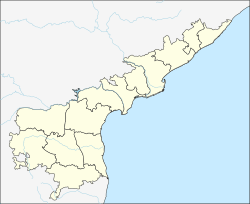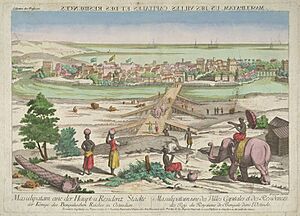Machilipatnam facts for kids
Quick facts for kids
Machilipatnam
Masulipatnam
Bandar |
|
|---|---|

Machilipatnam Center
|
|
| Country | India |
| State | Andhra Pradesh |
| District | Krishna district |
| Founded | 14th century |
| Government | |
| • Type | Municipal Corporation |
| • Body | Machilipatnam Municipal Corporation, MUDA |
| Area | |
| • City | 26.67 km2 (10.30 sq mi) |
| Elevation | 14 m (46 ft) |
| Population | |
| • Density | 6,875/km2 (17,810/sq mi) |
| • Urban | 232,000 |
| Languages | |
| • Official | Telugu |
| Time zone | UTC+5:30 (IST) |
| PIN |
521001,002,003,004
|
| Telephone code | 91-08672 |
| Vehicle registration | AP-39 |
Machilipatnam, also called Masulipatnam and Bandar, is a city in the Krishna district of Andhra Pradesh, India. It is a municipal corporation and the main office for the Krishna district. This old port city was a home for European traders starting in the 1500s. It was a very important trading port for the Portuguese, British, Dutch, and French in the 1600s.
Contents
What's in a Name?
In the 1600s, the city was known as Masulipatnam. In the local Telugu language, 'Masuli' or 'Machili' means fish. 'Patnam' means city. So, it means "Fish City." It was also called Bandar, which means 'port' in Persian language. In ancient times, the port town was also known as Maesolia.
A Look Back: Machilipatnam's History
This city has been around for a very long time, at least since 300 BCE. Back then, it was known as Maisolos. The port is located on the southeastern coast of India, called the Coromandel Coast. It sits at the mouth of the River Krishna by the Bay of Bengal. This location made it a busy place for sea trade.
Muslin Trade and Roman Coins
Ancient Greeks traded a special fabric called muslin from this town. The word muslin actually comes from the name Maisolos. Muslin was a big source of money for the town. Roman traders loved it for their homes. Many Roman coins have been found during digs near Machilipatnam. This shows how much trade happened here.
A Key Port for Kingdoms
Machilipatnam was the main seaport for the Kingdom of Golkonda. It was where textiles made in the Godavari Delta were sent out to other places. This port brought a lot of wealth to the kingdom in the 1620s and 1630s.
Changes and Decline
By the end of the 1600s, the port city started to decline. This happened around the time of the Mughal conquest of Golkonda. The British took over the Circars from the French in 1759. They gave them back to the Nizam, but they kept Masulipatnam for the East India Company. The town became the main office for the Masulipatnam district, which later became the Krishna district in 1859.
Where is Machilipatnam?
Machilipatnam city is located at 16°10′N 81°08′E / 16.17°N 81.13°E on the southeast coast of India. It is on the east coast of Andhra Pradesh. The city is about 14 meters (45 feet) above sea level.
Weather and Climate
Machilipatnam gets most of its yearly rain from the southwest monsoon. It has a tropical savanna climate with hot summers and mild winters. The hottest months are from April to June. The average rainfall is about 959 millimeters (37.8 inches).
The city can be affected by cyclones. In 1977, a strong cyclone hit the coast nearby. It caused a storm surge, which is a big wall of water from the sea, about 5 meters (16 feet) high. This surge flooded the coast south of the city. To help with this, a special radar system was put in place in 2004. This radar helps track cyclones and warn people along the coast.
| Climate data for Machilipatnam (1981–2010, extremes 1901–2012) | |||||||||||||
|---|---|---|---|---|---|---|---|---|---|---|---|---|---|
| Month | Jan | Feb | Mar | Apr | May | Jun | Jul | Aug | Sep | Oct | Nov | Dec | Year |
| Record high °C (°F) | 34.5 (94.1) |
37.4 (99.3) |
42.2 (108.0) |
44.4 (111.9) |
47.8 (118.0) |
47.0 (116.6) |
41.7 (107.1) |
39.8 (103.6) |
38.2 (100.8) |
37.8 (100.0) |
35.0 (95.0) |
34.6 (94.3) |
47.8 (118.0) |
| Mean daily maximum °C (°F) | 29.0 (84.2) |
30.8 (87.4) |
33.1 (91.6) |
35.1 (95.2) |
37.5 (99.5) |
36.9 (98.4) |
33.9 (93.0) |
32.9 (91.2) |
32.9 (91.2) |
31.7 (89.1) |
30.4 (86.7) |
29.1 (84.4) |
32.8 (91.0) |
| Mean daily minimum °C (°F) | 20.0 (68.0) |
21.3 (70.3) |
23.3 (73.9) |
25.9 (78.6) |
27.9 (82.2) |
27.6 (81.7) |
26.2 (79.2) |
26.0 (78.8) |
25.9 (78.6) |
24.7 (76.5) |
22.3 (72.1) |
20.3 (68.5) |
24.3 (75.7) |
| Record low °C (°F) | 13.4 (56.1) |
14.4 (57.9) |
16.7 (62.1) |
18.0 (64.4) |
17.8 (64.0) |
20.0 (68.0) |
19.0 (66.2) |
19.0 (66.2) |
18.3 (64.9) |
18.0 (64.4) |
13.9 (57.0) |
13.2 (55.8) |
13.2 (55.8) |
| Average rainfall mm (inches) | 8.8 (0.35) |
12.4 (0.49) |
7.4 (0.29) |
7.3 (0.29) |
40.1 (1.58) |
98.8 (3.89) |
184.9 (7.28) |
181.2 (7.13) |
173.2 (6.82) |
196.3 (7.73) |
104.5 (4.11) |
17.1 (0.67) |
1,031.9 (40.63) |
| Average rainy days | 0.6 | 0.7 | 0.4 | 0.4 | 1.8 | 5.6 | 10.6 | 10.4 | 8.4 | 8.7 | 3.7 | 0.8 | 51.9 |
| Average relative humidity (%) (at 17:30 IST) | 68 | 68 | 68 | 68 | 63 | 58 | 67 | 69 | 73 | 76 | 73 | 69 | 68 |
| Source: India Meteorological Department | |||||||||||||
Who Lives in Machilipatnam?
| Historical population | ||
|---|---|---|
| Year | Pop. | ±% |
| 1871 | 36,188 | — |
| 1881 | 35,056 | −3.1% |
| 1891 | 38,809 | +10.7% |
| 1901 | 39,507 | +1.8% |
| 1911 | 42,123 | +6.6% |
| 1921 | 43,940 | +4.3% |
| 1931 | 56,928 | +29.6% |
| 1941 | 59,146 | +3.9% |
| 1951 | 77,953 | +31.8% |
| 1961 | 101,417 | +30.1% |
| 1971 | 112,612 | +11.0% |
| 1981 | 138,525 | +23.0% |
| 1991 | 159,110 | +14.9% |
| 2001 | 179,353 | +12.7% |
| 2011 | 169,892 | −5.3% |
According to the 2011 census, Machilipatnam had a population of 232,000 people. There were more females than males, with 1047 females for every 1000 males. The city has a high literacy rate of 83.32%. This is much higher than the average for the state.
How the City is Run
The Machilipatnam Municipal Corporation is the local government for the city. It started as a municipality in 1866 and became a corporation in 2015. It covers an area of about 26.67 square kilometers (10.30 sq mi). The Machilipatnam Urban Development Authority is also in charge of planning for the city's growth.
Machilipatnam's Economy
Machilipatnam is famous for its handloom industry. This industry makes Kalamkari textiles. These special fabrics are exported to the United States and other Asian countries.
Other important local businesses include boat building and fishing. In the 1600s, Machilipatnam was a trading center for Europeans. It was known for making copper coins and exporting diamonds and textiles through its port.
The government of Andhra Pradesh is working to make the city's port important again. In 2019, construction began on a new deep seaport. This project also includes an industrial corridor to help the local economy grow.
Culture and Traditions
Art and Handicrafts
Machilipatnam Kalamkari is a special type of handcrafted and dyed fabric painting. It is made in the nearby town of Pedana. This unique style is recognized as a geographical indication from Andhra Pradesh. The Machilipatnam and Srikalahasti styles are the only two types of Kalamkari art still made in India.
Dance
Kuchipudi is a very popular Indian Classical Dance form. It began in a village called Kuchipudi, which is only 25 kilometers (15.5 miles) from Machilipatnam.
Delicious Food
The city is well known for two delicious sweets: Bandar Laddu and Bandar Halwa.
Places of Worship
Machilipatnam has many religious places. These include the Panduranga Temple at Chilakalapudi and the Agastheeswara Temple. Dattashram is a pilgrimage site on the coast. It has old Shiva and Datta temples. Manginapudi is also known as "Datta Rameswaram." This is because it has 12 wells for bathing, similar to those at Rameswaram.
Fun Things to See
Manginapudi Beach is a beautiful beach on the city's coast. Machilipatnam also has old buildings that were built by the Europeans who lived here long ago.
Getting Around
Roads
The city has a total road length of about 359.09 kilometers (223.13 mi). National Highway 65 connects Machilipatnam to Pune. It passes through Hyderabad, Suryapet, and Vijayawada. NH 216 also goes through the city, connecting Kattipudi to Ongole.
Buses
The city's bus station is run by the Andhra Pradesh State Road Transport Corporation. It has a bus depot to store and maintain buses.
Trains
Machilipatnam railway station is an important train station. It is the end station of the Vijayawada-Machilipatnam branch line. This line connects to the main train line at Vijayawada.
Port
The Machilipatnam port was badly damaged by a huge ocean wave in 1864. Since then, there have been many efforts to build a new port. A company called Navayuga Engineering Company Limited is building a deep water port at Gilakaladinne in the city.
Airport
The closest international airport is Gannavaram, Vijayawada. It is about 63 kilometers (39 miles) away.
Learning in Machilipatnam
Education in Machilipatnam is provided by government, aided, and private schools. These schools are part of the state's School Education Department. Krishna University is also located in Machilipatnam.
Famous People from Machilipatnam
- Divi Gopalacharlu - An expert in Ayurvedic medicine.
- Timmarusu - The Prime Minister for Raja Krishnadevaraya, an emperor of the Vijayanagara Empire.
- Pingali Venkayya - An independence activist who designed the national flag of India.
- Chitrapu Narayana Murthy - An Indian director known for films like AVM's Bhaktha Prahlada.
- Mutnuri Krishna Rao - An independence activist and journalist.
- U. G. Krishnamurthy - A philosopher.
- Bhogaraju Pattabhisitaramayya - An Indian independence activist and political leader.
- Raghupathi Venkaiah Naidu - Known as the father of Telugu cinema, an Indian artist and filmmaker.
- C. K. Nayudu - A famous Indian cricketer.
- Poornima - An Indian actress who acted in many films.
- Jagapathi Babu - A Telugu actor.
- B. Vasantha - A South Indian playback singer.
- Master Venu - A music composer for Telugu and Tamil films.
- C. S. R. Anjaneyulu - An Indian film actor and theater artist.
- Nirmalamma - A Telugu actress known for playing grandmother roles.
- Maruthi - An Indian director, screenwriter, and producer.
- Mani Sharma - An Indian composer and singer.
- Achyuth - An Indian actor.
- Srikanth Bolla - The first Indian blind boy to study at Massachusetts Institute of Technology. He is also an entrepreneur.
- Turaga Desiraju - A neurophysiologist and professor.
Images for kids
See also
 In Spanish: Machilipatnam para niños
In Spanish: Machilipatnam para niños






